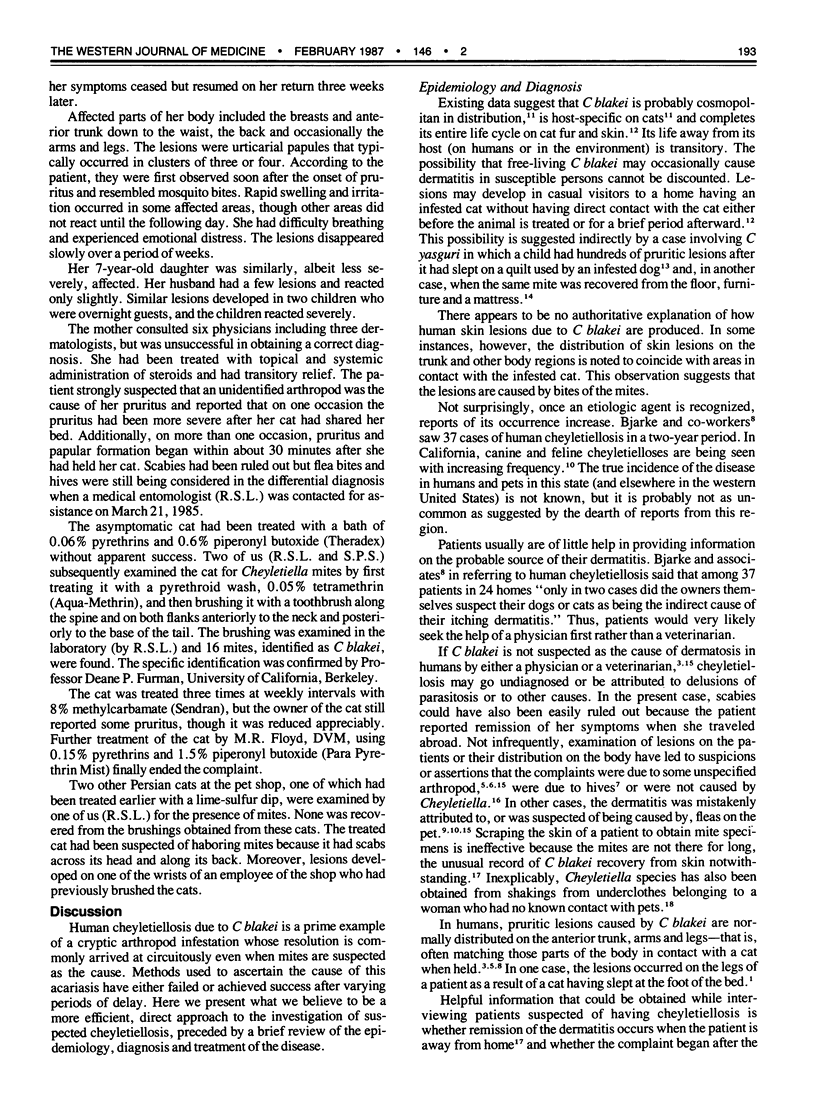Abstract
Cheyletiella blakei, an ectoparasitic mite of domestic cats, can cause an extremely annoying, persistent and pruritic dermatosis of obscure origin (cryptic infestation) in susceptible persons having close contact with infested cats. Although the prevalence of cheyletiellosis in humans and cats appears to be low, evidence of its occurrence in California is increasing. Cheyletiellosis is often underdiagnosed in both its natural host and in humans. The small size of the mite, lack of publicity about the disease, frequent absence of symptoms in infested cats and failure to recover the mite from humans contribute to its delayed recognition. When C blakei or other mites are suspected of being the cause of a dermatosis, medical entomologists may help to hasten the diagnosis by examining the patient's physical surroundings, potential vertebrate hosts and other sources for the presence of mites. After C blakei has been eliminated from cats with an appropriate pesticide, the disease in humans is self-limiting.
Full text
PDF


Selected References
These references are in PubMed. This may not be the complete list of references from this article.
- Bjarke T., Hellgren L., Orstadius K. Cheyletiella parasitivorax dermatitis in man. Acta Derm Venereol. 1973;53(3):217–223. [PubMed] [Google Scholar]
- Bronswijk J. E., De Kreek E. J. Cheyletiella (Acari: Cheyletiellidae) of dog, cat and domesticated rabbit, a review. J Med Entomol. 1976 Dec 8;13(3):315–327. doi: 10.1093/jmedent/13.3.315. [DOI] [PubMed] [Google Scholar]
- FERNSTROM A. J., GENTELE H. Dermatitis caused by mites living on cats. Acta Paediatr. 1960 Nov;49:752–753. doi: 10.1111/j.1651-2227.1960.tb16083.x. [DOI] [PubMed] [Google Scholar]
- Fox J. G., Hewes K. Cheyletiella infestation in cats. J Am Vet Med Assoc. 1976 Aug 1;169(3):332–333. [PubMed] [Google Scholar]
- Fox J. G., Reed C. Cheyletiella infestation of cats and their owners. Arch Dermatol. 1978 Aug;114(8):1233–1234. [PubMed] [Google Scholar]
- Hewitt M., Turk S. M. Cheyletiella sp. in the personal environment with notes on the differences between C. parasitivorax Mégnin and C. yasguri Smiley. Br J Dermatol. 1974 Jun;90(6):679–683. doi: 10.1111/j.1365-2133.1974.tb06697.x. [DOI] [PubMed] [Google Scholar]
- McKeever P. J., Allen S. K. Dermatitis associated with Cheyletiella infestation in cats. J Am Vet Med Assoc. 1979 Apr 1;174(7):718–720. [PubMed] [Google Scholar]
- Moxham J. W., Goldfinch T. T., Heath A. C. Cheyletiella parasitivorax infestation of cats associated with skin lesions of man. N Z Vet J. 1968 Apr;16(4):50–52. doi: 10.1080/00480169.1968.33746. [DOI] [PubMed] [Google Scholar]
- PIRILA V., MUROMA A. Dermatitis caused by mites (Cheyletiella parasitivorax) living on cats. Acta Derm Venereol. 1957;37(5):376–381. [PubMed] [Google Scholar]
- Roth J., Krause M. Beurteilung wetterabhängiger Atemnot durch bodyplethysmographische Prüfung der bronchialen Reaktivität. Z Gesamte Inn Med. 1978 Jul 1;33(13):444–445. [PubMed] [Google Scholar]
- Shelley E. D., Shelley W. B., Pula J. F., McDonald S. G. The diagnostic challenge of nonburrowing mite bites. Cheyletiella yasguri. JAMA. 1984 May 25;251(20):2690–2691. [PubMed] [Google Scholar]
- van Bronswijk J. E., Jansen L. H., Ophof A. J. Invasion of a house by the dog parasite Cheyletiella yasguri (Smiley 1965), a mite causing prurigo in man. Dermatologica. 1972;145(5):338–343. doi: 10.1159/000252062. [DOI] [PubMed] [Google Scholar]


